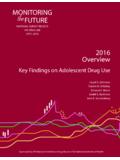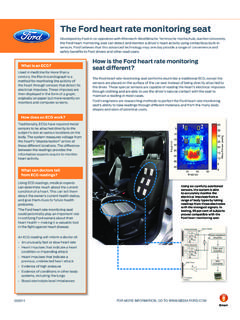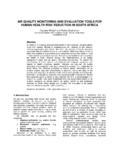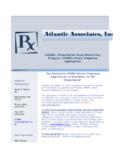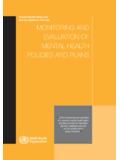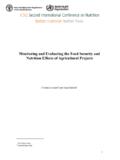Transcription of Global Water Supply and Sanitation Assessment …
1 Global Water Supply andSanitation Assessment 2000 ReportWORLD HEALTHORGANIZATIONThe WHO and UNICEF Joint monitoring Programme for Water Supply andSanitation (JMP) provides a snapshot of Water Supply and Sanitation worldwide atthe turn of the millennium using information available from different 2001 the JMP database for both historic data and future projections will be periodically updated. All assistance in identifying unused and new data toimprove the estimates presented here is Water Supply and Sanitation Assessment 2000 ReportWHO Library Cataloguing-in-Publication DataGlobal Water Supply and Sanitation Assessment 2000 Water Supply statistics 2.
2 Water resources development 3. Sanitation statistics I. WHO/UNICEF Joint monitoring Programme for Water Supply and Sanitation (ISBN 92 4 156202 1) (NLM classification: WA 675) 2000 world health organization and United Nations Children's FundPublications of the world health organization and the United Nations Children's Fundenjoy copyright protection in accordance with the provisions of Protocol 2 of theUniversal Copyright Convention. All rights reserved. The designations employed in this publication and the presentation of the material donot imply the expression of any opinion whatsoever on the part of the Secretariat of theWorld health organization or the United Nations Children's Fund concerning the legalstatus of any country, territory, city or area or of its authorities, or concerning the delim-itation of its frontiers or boundaries.
3 The mention of specific companies, or of certain manufacturers products, does notimply that they are endorsed or recommended by the world health organization or theUnited Nations Children's Fund in preference to others of a similar nature that are notmentioned. Errors and omissions excepted, the names of proprietary products are distinguished by initial capital world health organization and the United Nations Children's Fund welcomerequests for permission to reproduce or translate their publications, in part or in and enquiries should be addressed to the Office of Publications, WorldHealth organization , Geneva, Switzerland, or to the Editorial and Publications Section,UNICEF, New York, USA, which will be glad to provide the latest information on anychanges made to the text, plans for new editions.
4 And reprints and translations by Iseman CreativePrinted in the United States of AmericaGlobal Water Supply and Sanitation Assessment 2000 ReportiiiGLOBAL Water Supply AND Sanitation Assessment 2000 REPORTC ontentsList of boxes, figures, maps and tables ..iiiForeword by the Director-General of WHO and the Executive Director of UNICEF ..vForeword from the Chairperson of the Water Supply and Sanitation Collaborative Council .. The Global Water Supply and Sanitation Assessment Main Background and Limitations of the Assessment 20002. Global Global Changes during the Regional coverage in 20003.
5 Sector Sector Investment in Africa, Asia, and Latin America and the Costs and tariffs of urban Quality of General planning and management4. Water Supply and Sanitation in large Informal Types of Water Supply Accounting for Water Water Types of Sanitation facility5. Challenges, future needs and Future Future needs and services Ways to face the Sustaining the Need for monitoring6. Water Supply and Sanitation Changes during the Trends and future needs7. Water Supply and Sanitation Changes during the Trends and future needs8. Latin America and the Water Supply and Sanitation Changes during the Trends and future needs9.
6 Water Supply and Sanitation Trends and future needs10. Water Supply and Sanitation Trends and future needs11. Northern Water Supply and Sanitation AMethodology for the Global Water Supply and Sanitation Assessment 2000 ..77 List of boxes, figures, maps and TablesBoxesBox :International development targets for Water Supply and Sanitation coverageBox : health hazards of poor Water Supply and sanitationBox :Cholera epidemicsBox : health benefits of improved Water Supply and sanitationBox : Water Supply and Sanitation technologies considered to be improved and thoseconsidered to be not improved Box :Community participation in problem-solving: the Participatory Hygiene AndSanitation Transformation (PHAST) approachBox :Support provided for the Water Supply and Sanitation sector in developing countriesBox.
7 Water contamination and loss in piped Water supplyBox : Sanitation barriers to progressBox :Implementation of Sanitation programmesBox :Population growthBox :Why people want latrinesBox :Sustainable Water Supply and Sanitation systemsBox :Sustaining operation and maintenance through good resource managementBox :Issues to address with improved sector monitoringBox :Performance indicators for African Water Supply and Sanitation utilitiesBox :Improving access to safe drinking- Water in the United Republic of TanzaniaBox :Better management in Zambia leads to increased access to Water supplyBox :Tajikistan: decreasing Water supplyBox :Nepal: the need to prioritize sanitationBox :Myanmar: social mobilization to increase latrine constructionBox :Viet Nam: increasing access to Water supplyBox :Honduras: the impact of natural disasters on Water supplyBox :Pacific islands: challenges for Sanitation promotion culture and traditionBox :Bottled and vended waters(continued)ivGlobal Water Supply and Sanitation Assessment 2000 ReportList of boxes, figures, maps and tables (cont.)
8 FiguresFigure :Distribution of the Global population not served with improved Water Supply , byregionFigure :Distribution of the Global population not served with improved Sanitation , byregionFigure : Global Water Supply coverageFigure : Global Sanitation coverageFigure :Total Water Supply coverage for Africa, Asia, and Latin America and the CaribbeanFigure : Sanitation coverage for Africa, Asia, and Latin America and the CaribbeanFigure : Water Supply coverage, by region, 2000 Figure : Sanitation coverage by region, 200 Figure :Urban Water Supply coverage by region, 2000 Figure :Rural Water Supply coverage by region, 2000 Figure :Urban Sanitation coverage by region, 2000 Figure :Rural Sanitation coverage by region, 2000 Figure :Africa, Asia, and Latin America and the Caribbean: Water Supply coverage by cate-gory of service, 1990 Figure :Africa, Asia, and Latin America and the Caribbean: Water Supply coverage by cate-gory of service, 2000 Figure :Africa, Asia, and Latin America and the Caribbean: Sanitation coverage by categoryof service, 1990 Figure :Africa, Asia, and Latin America and the Caribbean: Sanitation coverage by categoryof service, 2000 Figure.
9 Annual investment in urban Water Supply for Africa, Asia, and Latin America andthe Caribbean, 1990 :Annual investment in rural Water Supply for Africa, Asia, and Latin America andthe Caribbean, 1990 2000 Figure :Annual investment in urban Sanitation for Africa, Asia, and Latin America and theCaribbean, 1990 2000 Figure :Annual investment in rural Sanitation for Africa, Asia, and Latin America and theCaribbean, 1990 2000 Figure :Total annual national and external investment in Water Supply and Sanitation forAfrica, Asia, and Latin America and the Caribbean, 1990 2000 Figure :Total annual investment in Water Supply compared to total annual investment insanitation for Africa, Asia, and Latin America and the Caribbean, 1990 2000 Figure :Median total investment in Water Supply and Sanitation as a proportion of overallgovernment investment, 1990 2000 Figure :A comparison of the median unit production cost of urban Water Supply and themedian tariff / production cost ratio by region, 1990 2000 Figure :Median Water Supply and sewerage tariffs by region, 1990 2000 Figure.
10 Average construction cost per person served of Water Supply facilities for Africa,Asia, and Latin America and the Caribbean, 1990 2000 Figure :Average construction cost of Sanitation facilities in Africa, Asia, and Latin Americaand the Caribbean, 1990 2000 Figure :Median percentage of rural Water supplies which are functioning, 1990 2000 Figure :Median percentage of wastewater treated by treatment plantsFigure :Plan status for Water and Sanitation coverageFigure :Target status for Water and Sanitation coverageFigure :Median coverage targets for Water Supply and Sanitation , by regionFigure :Management of rural Water supplyFigure :Population growth rates and proportions living in informal settlements: regionalmeans for the largest citiesFigure : Water Supply in the largest cities: mean percentage of the population with eachtype of service, by regionFigure :Median unaccounted-for Water in large cities in Africa, Asia, Latin America and theCaribbean, and Northern AmericaFigure :Percentage of household connections metered, and percentage of meters replacedannually: regional means for the largest citiesFigure.










